Freedom on the Menu: Is Your Glucose Beating the National Average?
.webp)
Key Takeways
At Nutrisense, we believe that a healthier America can exist. While we offer personalized support so our members can take control of their health, we also keep an eye on collective data. In this case, America’s collective glucose curve.
We gathered real-time glucose data from 100,000 members who use continuous glucose monitors (CGMs) to get a sneak peek into what happens in our bodies through the year.
Monitoring blood glucose with CGMs is not about one-size-fits-all levels or about catching a single high or low number. As our nutritionists always tell us, watching trends and swings is much more important here.
Our data showed us some eye-opening swings, especially around the holidays. These can be a big deal because they put extra stress on your body’s ability to regulate blood sugar, which can lead to long-term issues like insulin resistance and a higher risk of diabetes. But here’s the good news: by working with our glucose-certified nutritionists, you can learn about mitigating them and making smarter choices. The result? More stable glucose levels for a healthier, happier you.
So, as you prepare to enjoy your Fourth of July festivities (and before you eat one of the 150 million hot dogs America consumes), keep these insights in mind. They could be the key to feeling great all summer long!
Read on to see how your glucose looks against America's national average!
A Snapshot of America’s Average Glucose Levels
Our snapshot illustrates the average daily glucose level aggregated for all of America from October 2022 to January 2024. As we mentioned, the most noticeable swings in the data were, unsurprisingly, around significant holidays like Thanksgiving and Christmas consistently.
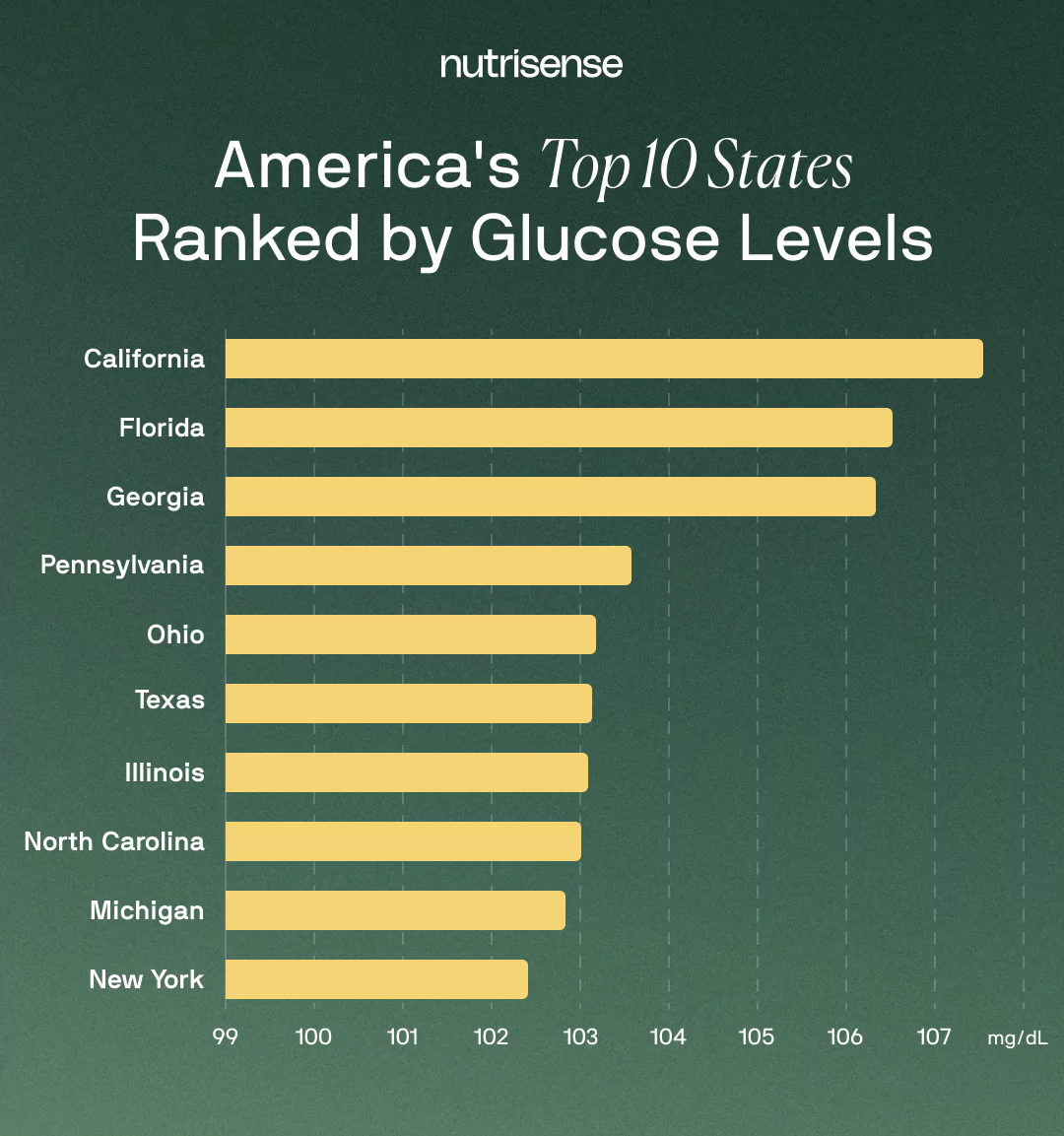
We also see a lot of variance among the different states—California, Florida and Georgia are, for example, not as healthy as other states when it comes to swings and dips.
Want to see how your state's glucose levels stack up against others? Here's an overview of average glucose levels across states from July 3-6, 2023, based on data from 100,000 members. We'll refresh, update, and add to this as we get more insights and data, so stay tuned as we continue to track America's glucose!
Why Monitoring Glucose Matters
With only 12 percent of American adults being metabolically healthy, monitoring key metrics like blood glucose levels is more important than ever to stay ahead of the game and keep your health in check.
“This isn't just about avoiding high sugar levels—it's about personalizing your lifestyle so you can have the freedom to eat various foods without feeling restricted and figuring out what activities and lifestyle habits are better suited to your body. Knowing more about glucose helps you determine which habits impact your blood sugar and how, so you can make better choices that lead to stable energy, better sleep, and overall health without feeling restricted!”
— Kara Collier, RDN, LDN, CNSC
VP of Health & Co-Founder at Nutrisense
America’s Glucose Through the Year and During Holidays
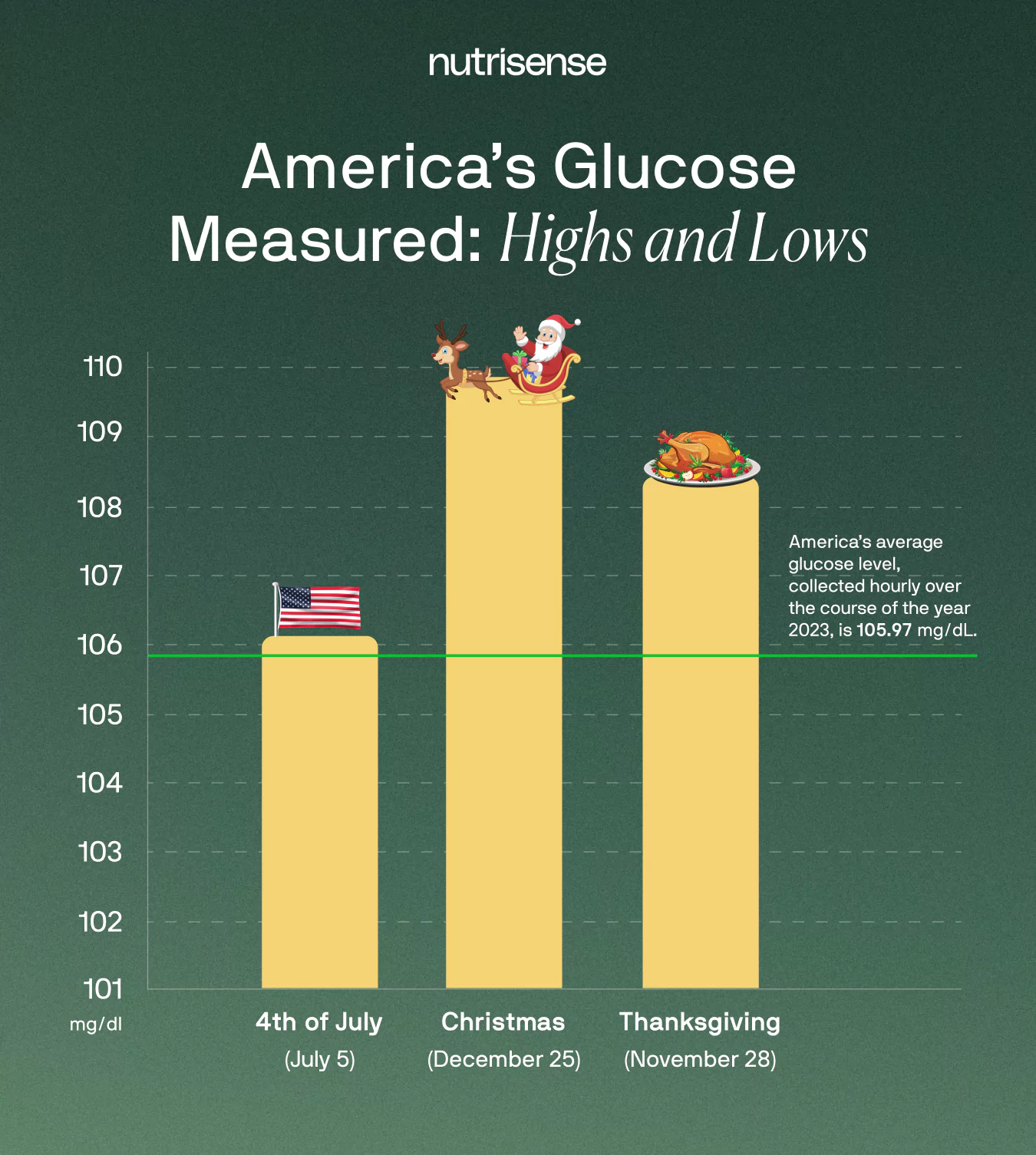
As we mentioned earlier, the data clearly reflects the impact of some of that holiday eating and all the celebrations. Were we surprised? Not really! With all the excitement around the holidays, we consume more added sugar, processed, and richer foods and maybe even sacrifice some healthy habits. This can lead to higher, more frequent glucose spikes.
Here’s some of what we saw over a few major holidays:
- December 25 saw the highest peak for the holidays, with +3.9 versus the average.
- Thanksgiving is a close second, with a peak of + 2.45 versus the average.
- On the Fourth of July, we saw a peak of +0.16 versus the average.
While any holiday can potentially derail usually healthy habits, we saw a bigger impact around the end of the year. After all, combine all that turkey, all those fixings, and a continual two months of social events and celebrations with shorter days, colder weather, more time indoors and less physical activity, and you’ve got the perfect recipe for glucose spikes. Of course, remember that it’s not just about the spike but also about how quickly levels come down after and what your normal levels look like.
Zooming in on the Fourth of July
Let’s talk about the holiday that’s right around the corner. It’s all about the fun, fireworks, and most importantly—the food! Traditional foods like hot dogs, burgers, and sugary sodas (not to mention all the desserts and alcohol) can lead to a significant jump in glucose levels.
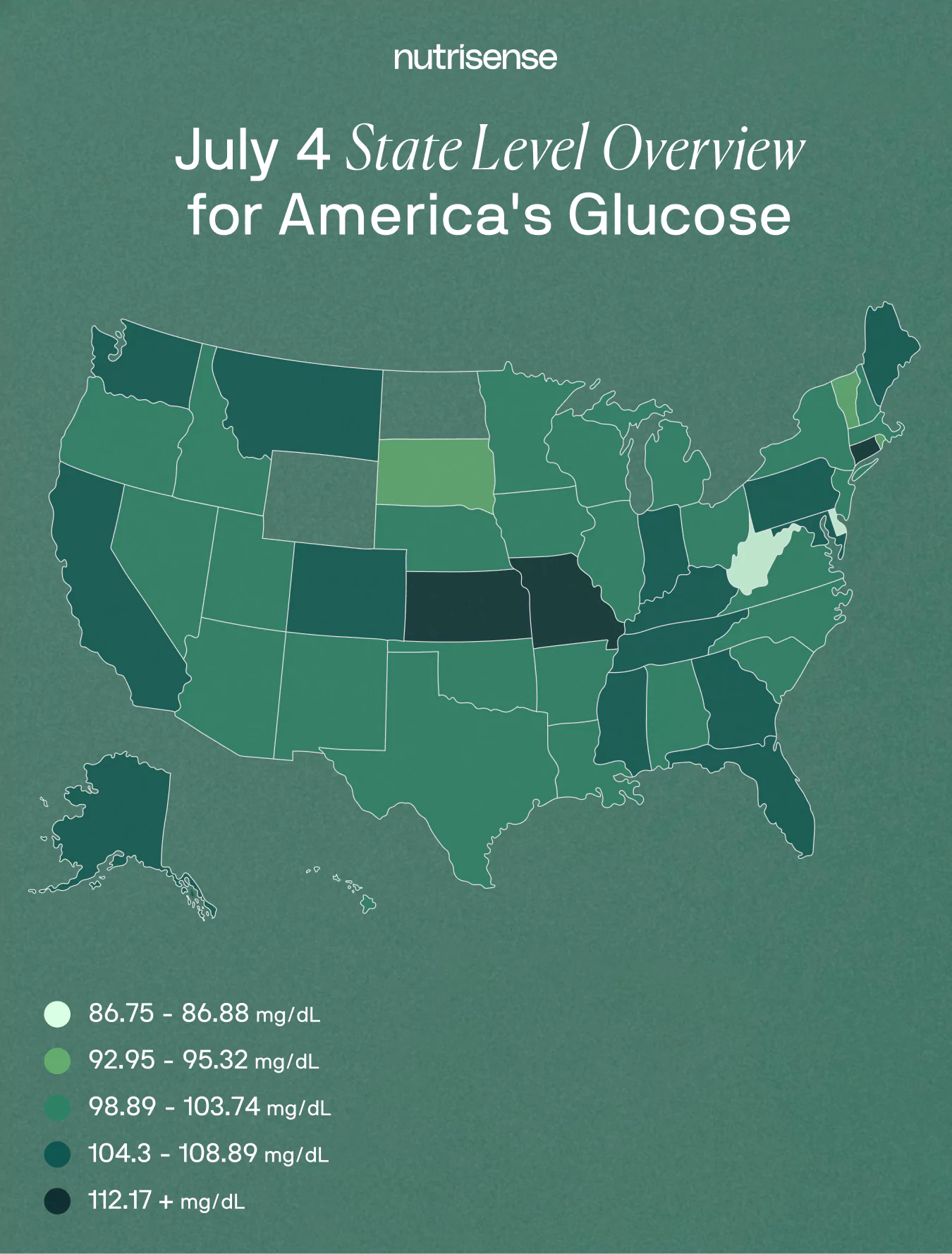
The Fourth of July (see some zoomed-in details by state in the picture above) may not swing as much as Thanksgiving and Christmas, but it did show similar patterns compared to the rest of the year.
As you can see from the varying numbers above across different states, understanding your specific body’s glucose trends with the help of an expert (like a glucose-certified nutritionist!) can help you make informed dietary choices to maintain stable glucose levels year-round. This will help you avoid any crazy swings and dips, even around the holidays.
We also looked deeper into what states were the most, and least healthy compared to the rest.
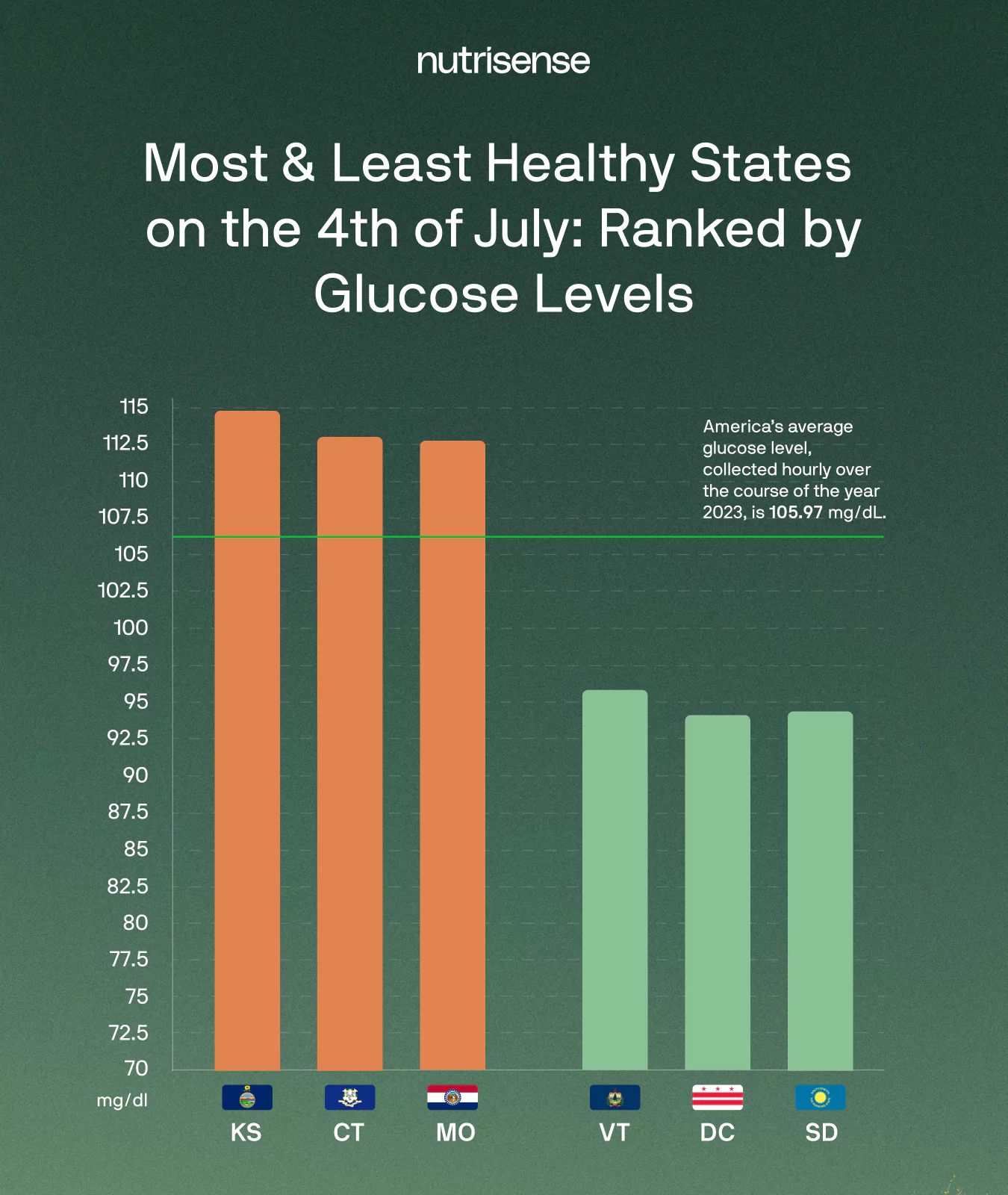
Fascinating, isn’t it? There could, of course, be several reasons: lifestyle, access to healthy food, and general habits all play a role in these state-specific glucose trends. The states above, where our data showed higher glucose responses on the Fourth of July, also seem to have lower physical activity levels (Kansas and Missouri in particular!).
Check out the map below showing the Prevalence of Self-Reported Physical Inactivity Among U.S. Adults by State and Territory. Is your state getting enough physical activity, or do you need to kick it up a notch?
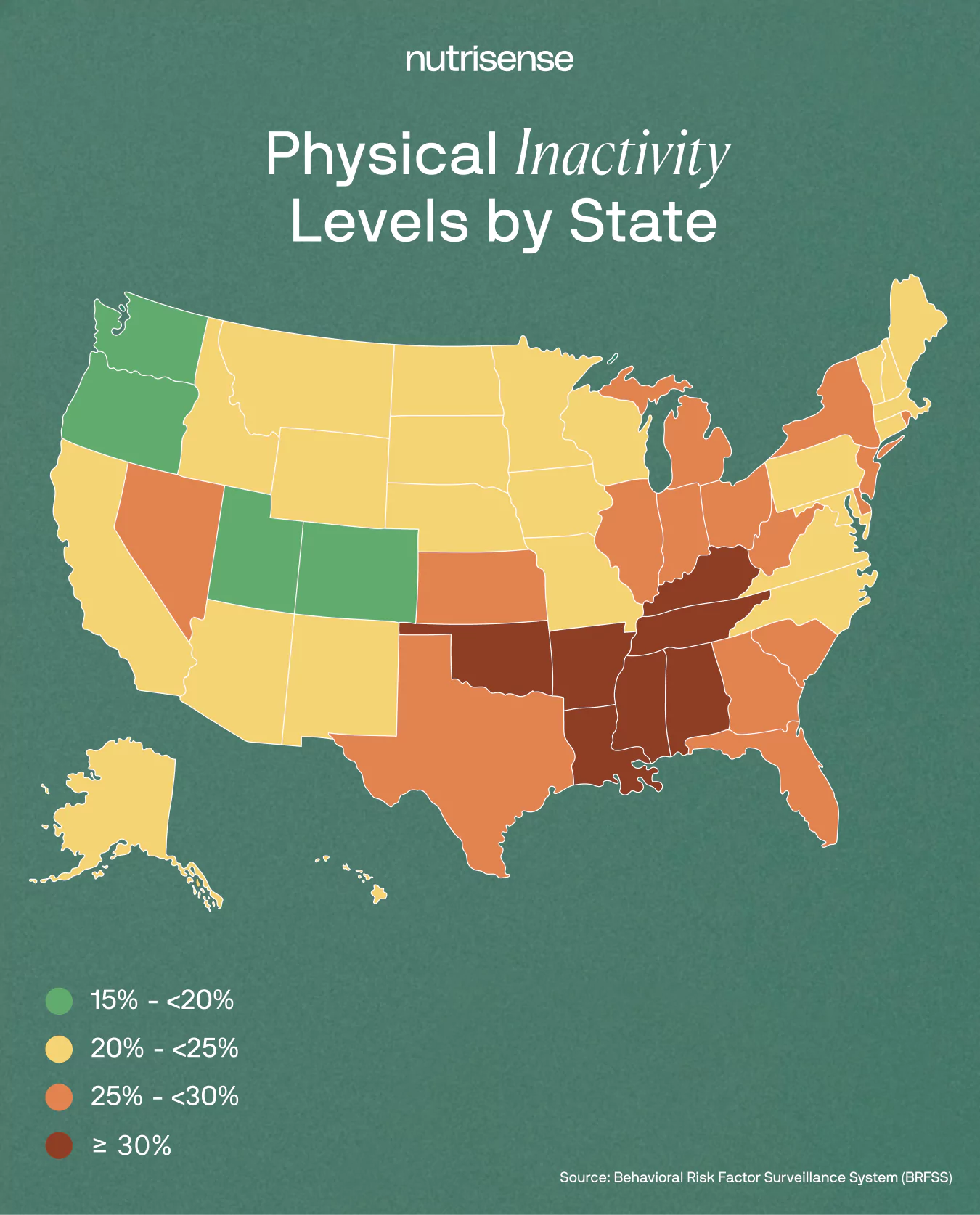
Top Fourth of July Foods Compared by Mean Glucose Peaks
At Nutrisense, we believe that understanding your glucose levels can lead to healthier and more enjoyable eating habits, especially during the holidays. You don’t have to sacrifice all your favorite foods, you just have to learn to eat to match your body’s unique responses!
Our board-certified nutritionists are here to help. They help decode your body’s data from continuous glucose monitors so you can understand it and provide personalized tips tailored to your health goals. We also provide access to a great app to track and monitor how different foods and activities affect your body.
After all, staying healthy is about so much more than just what you eat and how much you exercise. We believe that a healthy dose of fun and good company can work wonders for your metabolism, too—all you have to do is balance it all out according to what your body needs.
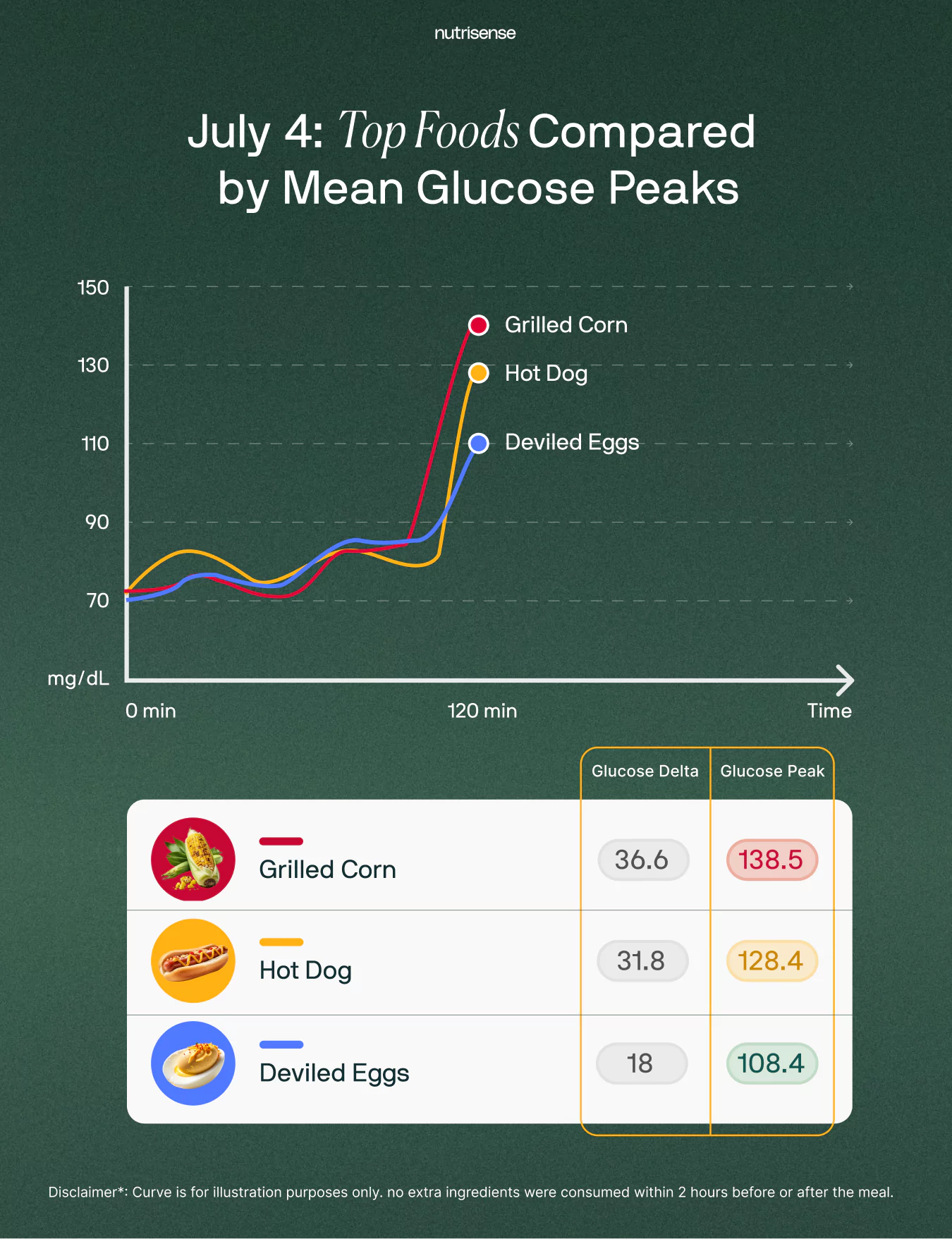
During our analysis, we also found that certain foods can have a more noticeable impact on glucose than others among those analyzed. As you can see from the image comparison above, out of the three, grilled corn could potentially lead to the most variability or higher fluctuations than hot dogs, even if the peak is within the range of a normal glucose level. You can see this reflected even more when compared with one of the best responses on our list, the deviled eggs.
The top three foods that peaked the highest from our data were grilled corn, macaroni salad, and hot dogs.
- Grilled corn,* for example, was associated with a glucose delta of 36.6 mg/dL, raising the mean glucose peak to 138.5 mg/dL.
- With macaroni salad,* we observed 32.4 mg/dL, with the mean glucose peak reaching 126.6 mg/dL.
- Hot dogs*, arguably one of the most popular foods during the Fourth of July, were associated with an average of 31.8 mg/dL, bringing the mean glucose peak to 128.4 mg/dL.
Of course, this doesn’t mean you should avoid these foods—simply be more mindful of what you pair them with, your food order, get some movement, and practice portion control. What is most important to look at here, rather than individual numbers, is the trend in your glucose to avoid too many crazy swings from your usual baseline.
A Nutritionist Explains the Reason for the Swings
Amanda Donahue, MS, RD, CD, adds a few quick explanations for the insights above, as well as ways to keep some of those swings at bay:
Test the grilled corn for yourself: “Corn is a low-GI food, but it contains natural carbohydrates that can raise blood sugar levels for some people. So, while on its own, it can lead to spikes for some people, it can be quite healthy if you’re mindful of your toppings and what you pair it with. Add lots of protein and vegetables to the mix to help with your response Here’s an experiment we did to highlight that for you!”
The best way to see if corn spikes your glucose is to try it out yourself, just like we did!
Swap some of the hot dog ingredients: “Hot dogs aren’t really ever thought of as a health food, so it’s likely no surprise they can impact your glucose levels too. Because they’re typically quite processed (although you can find some healthier versions of the sausage itself), can be high in added sugar, sodium, and preservatives, and low in fiber, they’re likely not the best part of your meal. However, some parts of a higher response could also be because of the refined carbohydrates in the bun, as well as the sauces and toppings you choose. Don’t sacrifice the treat if you love it! Instead, consider swapping out for a whole-grain bun, pick a healthier sausage, and pair it with a side salad and some vegetables to up the nutritional value. And, of course, eat it in moderation and test your response!”
Consider some whole-grain macaroni: “One of the riskiest foods from our data was macaroni salad, which is a dish that could lead to unbalanced glucose levels. It’s high in carbs, has a creamy, mayonnaise-heavy dressing, and is typically made with refined flour (with a high glycemic index). Some types can also have high saturated fat content. Combined, this can quickly raise your blood sugar levels and add to your caloric load. Consider a lighter version with whole-grain pasta and a vinaigrette dressing. You can also add some apple cider vinegar to your vinaigrette to help curb glucose responses.”
Remember that your glucose responses will be unique to your body. So, while these insights are fascinating, what’s really interesting is seeing your own reactions. For example, even the best on this list, the deviled eggs (we saw an average glucose spike of 18 mg/dL, bringing the mean glucose peak among the participants analyzed to 108.4 mg/dL), could spike higher or lower depending on your unique body. With the mayonnaise dressing, they may not be the healthiest choice, depending on your specific health goals.
Of course, with a few easy swaps (try swapping the mayo for Greek yogurt!), you can find a way to mitigate, manage, and work with any foods you enjoy if you understand your body's response to them.
Celebrate Smart: Top Tips for a Balanced 4th of July
Yes, you can enjoy the Fourth of July (or any other holiday) to the fullest without worrying about taking your glucose on a rollercoaster ride. Beat the statistics with a few tweaks to your day and some simple food swaps. Here’s just some of what our experts recommend:
Grab some water: Did you know the Fourth of July is one of the top beer-drinking holidays in the U.S.? Even if you’re not a beer drinker, you could be one of 43% of Americans who prefer soda with their meals. Remember, water may be key in managing glucose levels and can effectively prevent glucose spikes, so stay well-hydrated through your celebrations.
Swap out some processed foods: Hot dogs may be the most popular, but interestingly, people also buy a lot of chicken (approximately 700 million pounds!) the week before the holiday. Chicken is a great lean protein that can help maintain stable glucose levels. Also, try eating more grilled vegetables.
Fill up on fruit and healthy sides: Don’t fill up on potato salad. Load up on healthier sides instead, like salads, and indulge your sweet tooth with some fruit, like watermelon (it’s the most popular fruit on the Fourth of July and perfect for the season!).
Stay active: It’s perfect pool-lounging weather, but remember to get moving to keep your glucose balanced. Get a few laps while you’re in the pool, enjoy a game of frisbee, or take a post-meal walk with family and friends.
Check out our Fourth of July article for more tips and some nutritionist-approved recipe swaps for Fourth of July classics.
Find the right Nutrisense programto turn insight into progress.
Go Beyond Glucose Data with Nutrisense
Your glucose can significantly impact how your body feels and functions. That’s why stable levels are an important factor in supporting overall wellbeing. But viewing glucose isn't enough. Nutrisense, you’ll be able to learn how to use your body's data to make informed lifestyle choices that support healthy living.
One-to-one coaching
Sign up to access insurance-covered video calls to work with a glucose expert: a personal registered dietitian or certified nutritionist who will help tailor your lifestyle and diet to your goals.
Monitor and measure what matters
With the Nutrisense CGM Program, you can monitor your glucose with health tech like glucose biosensors and continuous glucose monitor (CGM)s, and analyze the trends over time with the Nutrisense App. This will help you make the most informed choices about the foods you consume and their impact on your health.
Find your best fit
Ready to take the first step? Start with our quiz to find the right Nutrisense program to help you take control.

Amanda is a Nutrition Manager and Registered Dietitian, with a Masters in Dietetics from Stephen F. Austin State University. Originally from south GA, she got her undergrad degree from Texas Tech University. She worked at a hospital in Fort Worth, TX, for 4 years as a dietitian, counseling those living with HIV.




